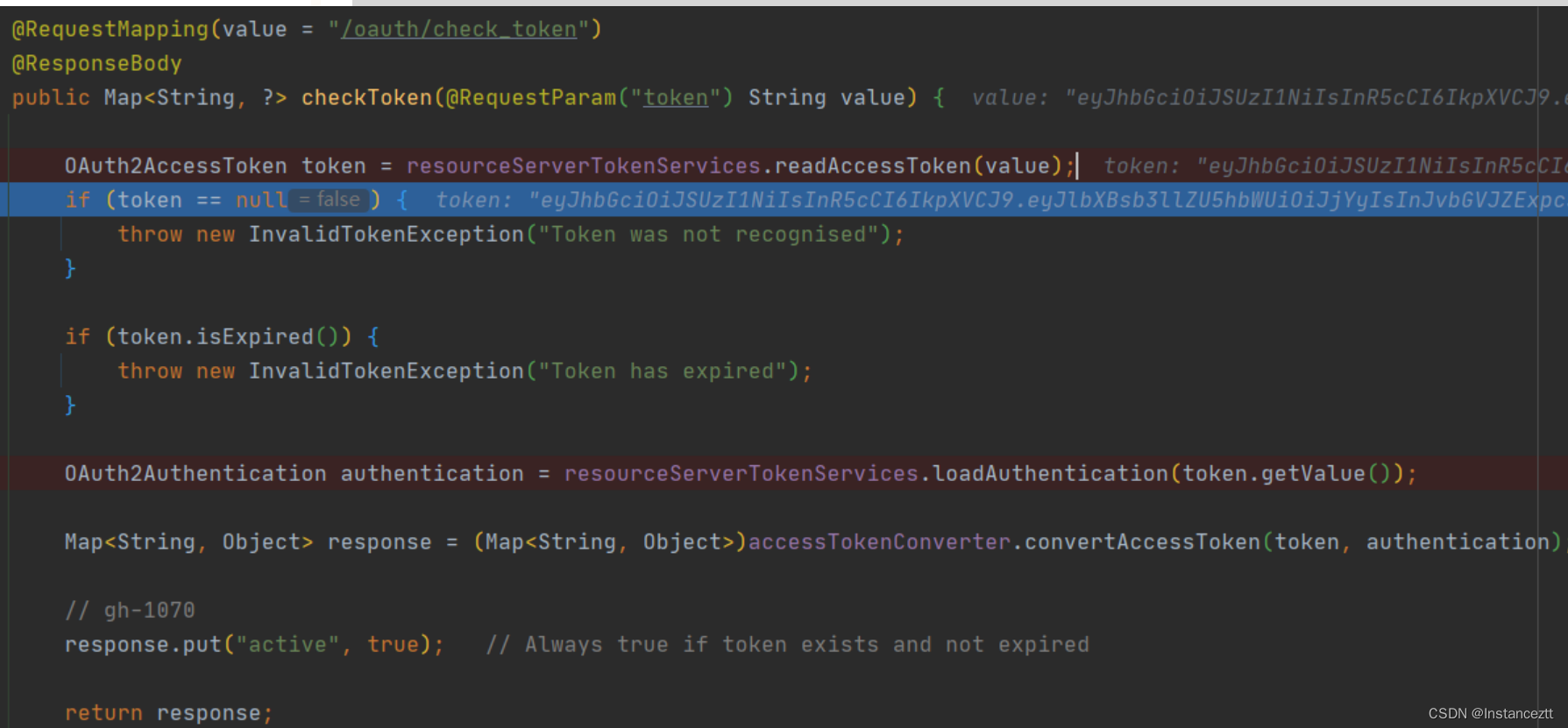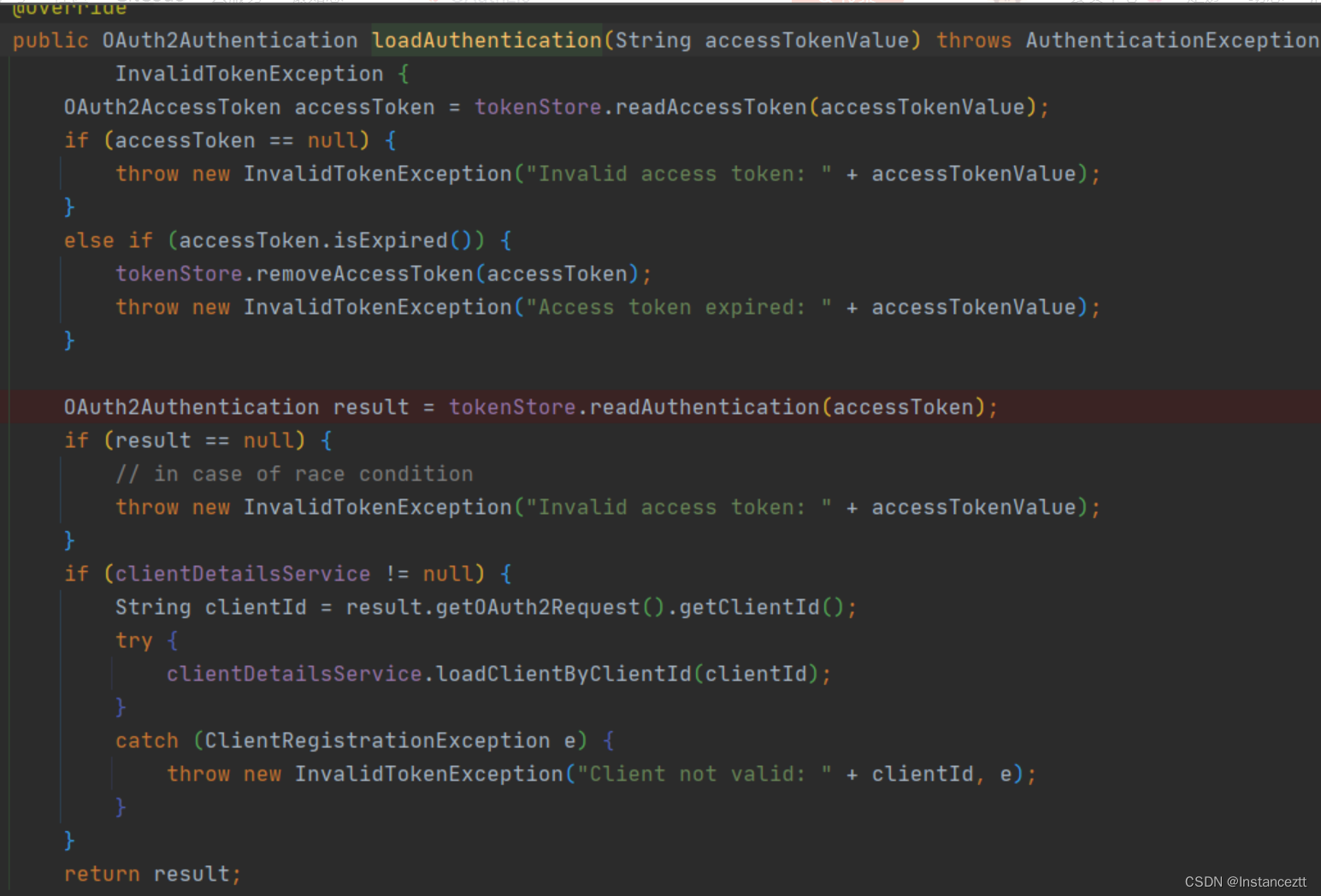一 引言
在上篇文章我们分析了token的获取过程,那么拿到token后,将token放在请求头中进行资源的访问,客户端是如如何对token进行解析的呢,本文带你走进token校验的源码解析,基本流程如下所示

- 客户端向资源服务器发起请求时,在请求头Authorization携带申请的token
- 请求被FilterChainProxy过滤器链拦截到,交由
OAuth2AuthenticationProcessingFilter过滤器 - 在OAuth2AuthenticationProcessingFilter中通过
TokenExtractor将请求头中的token转换为Authentication - 然后调用OAuth2AuthenticationManager.authenticate(authentication)方法,在改方法里面会通过
RemoteTokenServices的loadAuthentication方法去向认证服务器发起token的校验 - 认证服务器首先进入
BasicAuthenticationFilter,对clientId等进行校验 - 然后进入
CheckTokenEndpoint,先从tokenStore中获取token,然后通过token在tokenStore中获取Authentication信息 - 最终返回授权结果
二 认证鉴权流程分析
请求被FilterChainProxy拦截到(ps:通过前面的文章查看其底层原理),通过OAuth2AuthenticationProcessingFilter作为权限校验的入口进行token校验
public class OAuth2AuthenticationProcessingFilter implements Filter, InitializingBean {
public void doFilter(ServletRequest req, ServletResponse res, FilterChain chain) throws IOException,
ServletException {
final boolean debug = logger.isDebugEnabled();
final HttpServletRequest request = (HttpServletRequest) req;
final HttpServletResponse response = (HttpServletResponse) res;
try {
// 1 通过tokenExtractor解析出请求头中的token封装到Authentication 中
Authentication authentication = tokenExtractor.extract(request);
if (authentication == null) {
if (stateless && isAuthenticated()) {
if (debug) {
logger.debug("Clearing security context.");
}
SecurityContextHolder.clearContext();
}
if (debug) {
logger.debug("No token in request, will continue chain.");
}
}
else {
request.setAttribute(OAuth2AuthenticationDetails.ACCESS_TOKEN_VALUE, authentication.getPrincipal());
if (authentication instanceof AbstractAuthenticationToken) {
AbstractAuthenticationToken needsDetails = (AbstractAuthenticationToken) authentication;
needsDetails.setDetails(authenticationDetailsSource.buildDetails(request));
}
// 2 通过authenticationManager对当前authentication 进行校验
Authentication authResult = authenticationManager.authenticate(authentication);
if (debug) {
logger.debug("Authentication success: " + authResult);
}
eventPublisher.publishAuthenticationSuccess(authResult);
SecurityContextHolder.getContext().setAuthentication(authResult);
}
}
catch (OAuth2Exception failed) {
SecurityContextHolder.clearContext();
if (debug) {
logger.debug("Authentication request failed: " + failed);
}
eventPublisher.publishAuthenticationFailure(new BadCredentialsException(failed.getMessage(), failed),
new PreAuthenticatedAuthenticationToken("access-token", "N/A"));
authenticationEntryPoint.commence(request, response,
new InsufficientAuthenticationException(failed.getMessage(), failed));
return;
}
chain.doFilter(request, response);
}
...
}
TokenExtractor解析token
public class BearerTokenExtractor implements TokenExtractor {
...
@Override
public Authentication extract(HttpServletRequest request) {
// 获得token的值
String tokenValue = extractToken(request);
if (tokenValue != null) {
// 将token封装到PreAuthenticatedAuthenticationToken 中
PreAuthenticatedAuthenticationToken authentication = new PreAuthenticatedAuthenticationToken(tokenValue, "");
return authentication;
}
return null;
}
protected String extractToken(HttpServletRequest request) {
// first check the header...
// 解析请求头中的token 就是请求头中的Authorization解析出来并将相应的前缀去掉
String token = extractHeaderToken(request);
// bearer type allows a request parameter as well
// 请求为空的话 则通过获取请求参数中的access_token
if (token == null) {
logger.debug("Token not found in headers. Trying request parameters.");
token = request.getParameter(OAuth2AccessToken.ACCESS_TOKEN);
if (token == null) {
logger.debug("Token not found in request parameters. Not an OAuth2 request.");
}
else {
request.setAttribute(OAuth2AuthenticationDetails.ACCESS_TOKEN_TYPE, OAuth2AccessToken.BEARER_TYPE);
}
}
return token;
}
/**
* Extract the OAuth bearer token from a header.
*
* @param request The request.
* @return The token, or null if no OAuth authorization header was supplied.
*/
protected String extractHeaderToken(HttpServletRequest request) {
Enumeration<String> headers = request.getHeaders("Authorization");
while (headers.hasMoreElements()) {
// typically there is only one (most servers enforce that)
String value = headers.nextElement();
if ((value.toLowerCase().startsWith(OAuth2AccessToken.BEARER_TYPE.toLowerCase()))) {
String authHeaderValue = value.substring(OAuth2AccessToken.BEARER_TYPE.length()).trim();
// Add this here for the auth details later. Would be better to change the signature of this method.
request.setAttribute(OAuth2AuthenticationDetails.ACCESS_TOKEN_TYPE,
value.substring(0, OAuth2AccessToken.BEARER_TYPE.length()).trim());
int commaIndex = authHeaderValue.indexOf(',');
if (commaIndex > 0) {
authHeaderValue = authHeaderValue.substring(0, commaIndex);
}
return authHeaderValue;
}
}
return null;
}
}
调用authenticationManager.authenticate(authentication);方法,这里的authenticationManager返回的是
OAuth2AuthenticationManager实例

public class OAuth2AuthenticationManager implements AuthenticationManager, InitializingBean {
// ....
public Authentication authenticate(Authentication authentication) throws AuthenticationException {
if (authentication == null) {
throw new InvalidTokenException("Invalid token (token not found)");
}
// 从authentication拿到上一步封token的值
String token = (String) authentication.getPrincipal();
// 调用RemoteTokenServices的loadAuthentication对token进行校验
OAuth2Authentication auth = tokenServices.loadAuthentication(token);
if (auth == null) {
throw new InvalidTokenException("Invalid token: " + token);
}
Collection<String> resourceIds = auth.getOAuth2Request().getResourceIds();
if (resourceId != null && resourceIds != null && !resourceIds.isEmpty() && !resourceIds.contains(resourceId)) {
throw new OAuth2AccessDeniedException("Invalid token does not contain resource id (" + resourceId + ")");
}
checkClientDetails(auth);
if (authentication.getDetails() instanceof OAuth2AuthenticationDetails) {
OAuth2AuthenticationDetails details = (OAuth2AuthenticationDetails) authentication.getDetails();
// Guard against a cached copy of the same details
if (!details.equals(auth.getDetails())) {
// Preserve the authentication details from the one loaded by token services
details.setDecodedDetails(auth.getDetails());
}
}
auth.setDetails(authentication.getDetails());
auth.setAuthenticated(true);
return auth;
}
...
}
RemoteTokenServices发起远程校验
public class RemoteTokenServices implements ResourceServerTokenServices {
// ...
@Override
public OAuth2Authentication loadAuthentication(String accessToken) throws AuthenticationException, InvalidTokenException {
// 封装请求参数
MultiValueMap<String, String> formData = new LinkedMultiValueMap<String, String>();
formData.add(tokenName, accessToken);
HttpHeaders headers = new HttpHeaders();
headers.set("Authorization", getAuthorizationHeader(clientId, clientSecret));
// 远程调用token校验 就是通过restTemplate发起http请求 请求的认证服务器接口http://认证服务器地址/oauth/check_token
Map<String, Object> map = postForMap(checkTokenEndpointUrl, formData, headers);
if (map.containsKey("error")) {
if (logger.isDebugEnabled()) {
logger.debug("check_token returned error: " + map.get("error"));
}
throw new InvalidTokenException(accessToken);
}
// gh-838
if (!Boolean.TRUE.equals(map.get("active"))) {
logger.debug("check_token returned active attribute: " + map.get("active"));
throw new InvalidTokenException(accessToken);
}
return tokenConverter.extractAuthentication(map);
}
private Map<String, Object> postForMap(String path, MultiValueMap<String, String> formData, HttpHeaders headers) {
if (headers.getContentType() == null) {
headers.setContentType(MediaType.APPLICATION_FORM_URLENCODED);
}
@SuppressWarnings("rawtypes")
Map map = restTemplate.exchange(path, HttpMethod.POST,
new HttpEntity<MultiValueMap<String, String>>(formData, headers), Map.class).getBody();
@SuppressWarnings("unchecked")
Map<String, Object> result = map;
return result;
}
}
三 认证服务器根据token鉴权
1 首先进入BasicAuthenticationFilter,对clientId进行校验(这里不做分析 参考上篇文章)
2、然后进入CheckTokenEndpoint,先从tokenStore中获取token

3. 调用resourceServerTokenServices.loadAuthentication方法,通过token在tokenStore中获取Authentication信息

最终返回授权结果